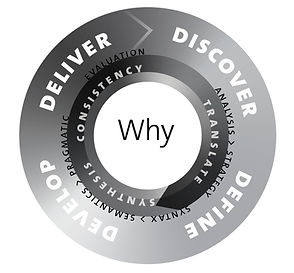The development process diagrammed is designed to define distinctive positioning amongst competitors, thus producing memorable and unique brand interactions. It blends design thinking research methods, semiotics (science of signs/meaning making) and competitive positioning to enhance all perceptions and experiences with a brand.
At the center is the “Why”, the concept developed by Simon Sinek who states that most companies’ messaging is mundane, talking about “What” products or services they offer. As well, they discuss “How” they do it and the things that set them apart. The “Why” is the language that addresses the purpose, cause or belief—the very reason for the organization to exist. It’s not about making money... that is a result.
People don’t buy what you do,
people buy why you do it.
— Simon Sinek

This design-research-oriented “design thinking” methodology seeks to reveal insights that guide innovation and brand positioning. It helps define the “Why” and ultimately solve complex communication problems to drive business growth.
The entire process is cyclical—continual evaluation and honing.
1
Discover
Audit
Internal + Competitors
A comprehensive review of both visual & verbal messaging
Research
Primary + Secondary
Usually includes quantitative & qualitative from internal and external audiences
The Discover Phases reveals strengths, weaknesses, opportunities and threats (SWOT) analysis as a foundation to positioning strategy development. Often insights from these activities can unearth new business opportunities as well as new
or refined business models.
2
Define
Brand Strategy
Brand Attributes
Defines the characteristics of a brand; serves as the semantic criteria of all visual & verbal development
Audience Persona
The amalgamation of the target audience including demo and psycho-graphics; describes aspirations, desires, ambitions and expectations
Positioning
Defines how the brand is perceived among the competitive set
Brand Architecture
Defines the brand’s family tree, significantly impacts perceptions and brand management
3
Develop
Verbal System
Voice + Tone
Parallels the brand attributes, characterizes the brand personality in written and spoken form
Nomenclature
Name or naming system and their qualifiers/descriptors
Tagline
A distillation of the brand that inspires internal and external audiences
Brand Promise
Defines the “Why”
Positioning Statement
Clarifies the entity’s unique value to its audience
Key Messages
Defines corporate core tenets
Acoustic Branding
Translation of the attributes to all things auditory—music, song/jingle, mnemonic/sonic indicator, lyrics, voice-over and spoken accent.
Visual Language System
Identifier (logo)
This keystone element can take the form of a symbol, wordmark, monogram or signature (wordmark + symbol lockup)
Color
The first perceived element and its palette system
Typography
More than fonts, how they are applied in informational hierarchy or expressionistic manner
Imagery
Photography, illustration or pattern and their unique style for the brand
Motion
The style, editing and kinetic behavior of the visual language elements
Icons
A series of marks that serve as visual shorthand to reinforce the brand’s language and information design
Composition
The syntax to all elements to uniquely express the brand
Information Design / Data Visualization / User Experiences
Developing a consistent approach to maps, charts, diagrams, exhibits, interactive models, usability & user interfaces and all brand related experiences
4
Deliver
Brand Guidelines
Management & Procedures Documentation
A document that serves as the brand’s playbook to aid in consistent application
Implementation
Executing on the defined brand in
all communications through strategic media/calendar planning
Typical
implementations
include:
Brand Essence Video
Brand Steward Brochure
Branded Environments
Data Visualization
Digital Tools & Presentations
Exhibit Design
Information Design
Instructional Videos
Literature Systems
Motion Graphics
On & Off-line Advertising
Packaging
Product Development
Signage / ID & Wayfinding
Social Media
Stationery Kit
Vehicles
Websites
